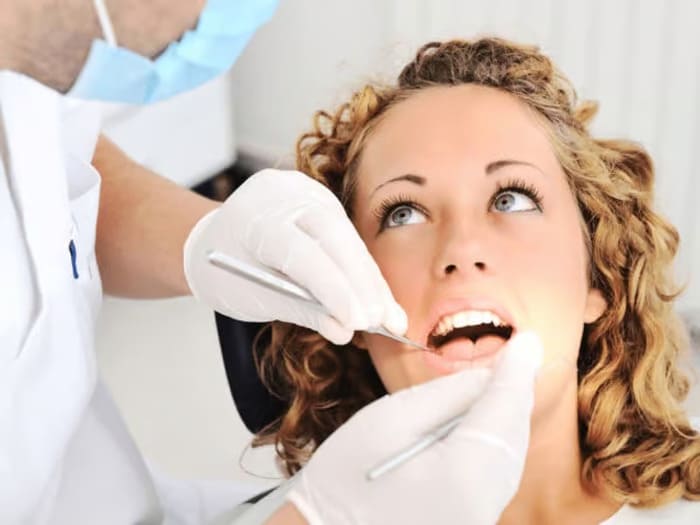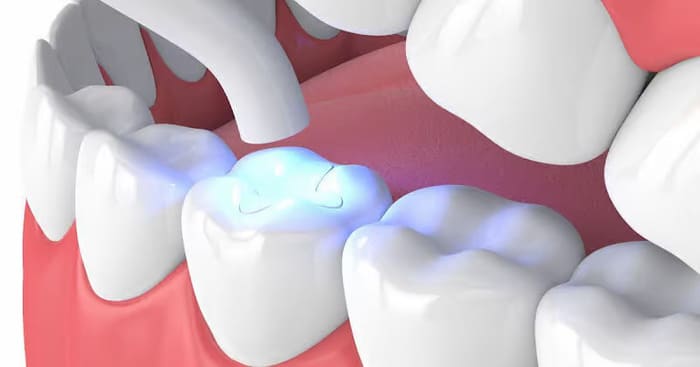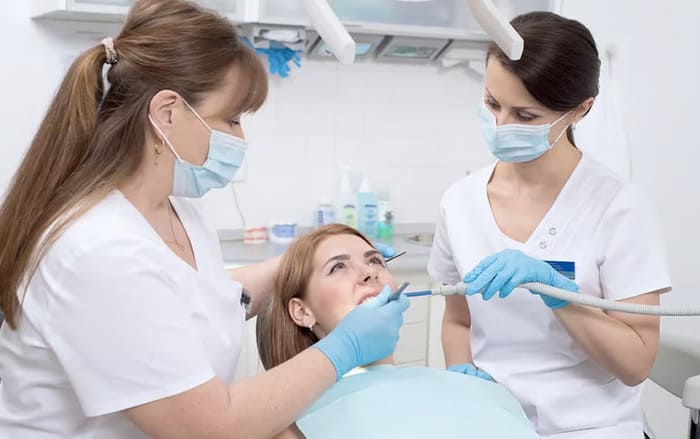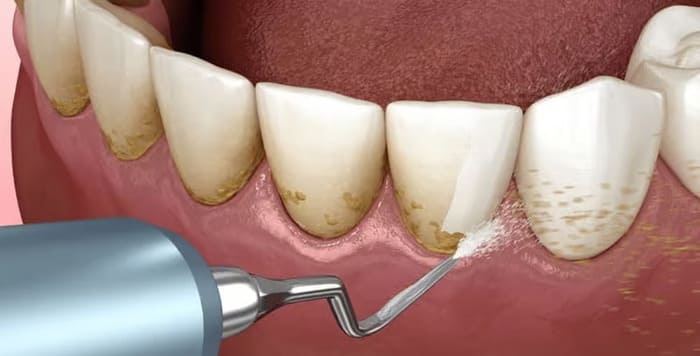How Long Should I Wait to Eat After a Filling?

Contents:
Tooth fillings are the easiest way to restore a crown and are used in most cases. The fillings look aesthetically pleasing thanks to the doctors’ skill and the use of high-quality materials.
The life expectancy and appearance of a photopolymer dental restoration over time depend not only on the filling technique but also on following all the dentist’s recommendations. One crucial aspect is the nutrition rules after the procedure, which will be discussed in this article.

How Does a Dental Filling Work?
A dental filling usually takes about 30 minutes to place. This is enough time to close the cavity in the crown and recreate the tooth’s anatomical shape and aesthetic appearance. Photopolymer materials are mainly used for permanent fillings; they are applied in layers and require light curing, after which the doctor does the final grinding. If aesthetic restoration of significant defects after caries or trauma is carried out, treatment can take 40-60 minutes.
If the procedure is performed correctly, the finished filling is invisible externally and feels like your own tooth in the mouth. If discomfort remains after the restoration, the dentist grinds the surface again to make the patient feel comfortable. After the procedure is completed, the dentist will recommend oral care.

Memo after Dental Caries Treatment and Dental Restorations
- If the treatment was done with anaesthesia, you should wait until the anaesthesia is over before eating and performing hygiene procedures.
- After filling, you should pay special attention to oral hygiene to keep your teeth in good condition and avoid new dental problems.
- For the first 2-3 days after filling, you should limit the chewing load on the treated tooth and avoid eating too hard food.
- Tooth sensitivity is possible in the first days after filling—this is a normal reaction to the manipulation. If the symptoms persist too long, you should revisit the dentist and check the tooth’s condition.
- If severe pain or bleeding of the gum occurs, you should see a doctor immediately.
Eating After Filling: Basic Recommendations
Tips depend on the type of filling. Modern photopolymer (light-curing) materials are often used to restore the dental crown. They acquire strength under the influence of UV light and subsequently practically do not change their properties. In this case, short-term and insignificant rationing changes are required. If chemical or temporary fillings are used, there will be more dietary restrictions, as these materials take longer to cure and have low durability.
How Long Should I Not Eat After a Tooth Filling?
You can eat 2 hours after the filling has been placed. Observing this restriction reduces the risk of damage to the composite material and allows you to guarantee a quality result of treatment. There are several reasons why you should not eat immediately after a visit to the dentist:
- During 1-2 hours, the anaesthetic effect is retained, so the sensitivity of the mucosa is reduced, and the control of chewing movements is impaired. The patient may accidentally bite the cheek or traumatise the filling without even noticing it.
- After caries treatment and filling placement, slight soreness and increased gingival sensitivity may occur. Eating food can exacerbate the discomfort.
- A newly placed restoration may irritate the tissue and nerve, causing the patient to have a slight toothache after the filling. Chewing and pressing on the filling increases the discomfort.
- Too cold or hot food negatively affects the adhesive properties of composite materials, so gaps form between the filling and the tooth’s dentin.
The above rules apply to permanent restorations made of durable, wear-resistant materials. After a temporary filling, you should not eat for 2-3 hours and limit the consumption of hard food. This recommendation should be strictly observed, as temporary tooth restorations use inexpensive, fragile materials easily damaged by mechanical impact.

Recommendations for the First Hours and Days After the Filling
In addition to diet restrictions, you should follow these guidelines for the first 2 hours after leaving the dentist’s office:
- Do not touch the filling with your tongue or hands;
- Do not brush your teeth or rinse your mouth;
- Do not use chewing gum;
- Do not suck on lollipops.
Do I Need to Follow a Diet, and How Do I Organise My Meals?
Pigments from food or drink can colour photopolymer materials. Immediately after placement, composites are most susceptible to colour change, so observe the restrictions for 2-3 days. What you should not eat or drink after a photopolymer filling:
- red coloured berries, vegetables, and fruits;
- strong tea and coffee;
- fruit juices;
- coloured fizzy drinks;
- coloured coated jelly beans;
- chocolate products.
Soft food at a comfortable temperature should be preferred on the first day after the filling. Dishes that are too spicy and irritate the mucous membranes should be avoided. Hard candies, nougat, and other sticky foods are also not recommended.
Oral Care After a Dental Filling
Care after the filling is no different from the usual home hygiene. Modern materials for fillings are resistant to mechanical impact, so regular cleaning will not harm them. For daily oral care, it is recommended to choose soft or medium hardness brushes, which clean well and do not traumatize the gums.
It is better to entrust the choice of toothpaste to your dentist, who will advise the best option, considering the state of enamel and gums. Do not overuse whitening and highly abrasive toothpastes, which scratch fillings and natural tooth enamel and increase tooth sensitivity.
What Is the Right Way to Perform Hygiene Procedures?
To maintain healthy teeth, it is essential to have regular home hygiene and the correctness of all its stages. As practice shows, most people brush their teeth with monotonous horizontal movements and do not pay enough attention to the interdental spaces and hard-to-reach places where plaque accumulates. This quickly leads to tooth decay and gum inflammation.
To keep your teeth healthy and prolong the life of your filling, you should:
- brush your teeth for at least 3 minutes;
- clean not only the front and chewing surface but also the inner (lingual) surface;
- make “sweeping” movements from the gums to the free edge of the teeth;
- clean the space between the teeth with floss;
- use mouthwash;
- Use an irrigator to remove food debris more thoroughly from hard-to-reach areas.

Another important thing is routine check-ups with your dentist. Even if nothing bothers you, you should visit the dentist every 6 months for an oral examination. During these visits, it is advisable to have professional dental hygiene: using ultrasound and Airflow, the doctor will remove dental deposits that cannot be removed by home cleaning. After the procedure, the smile looks whiter and more attractive, reducing the risk of tooth decay.


